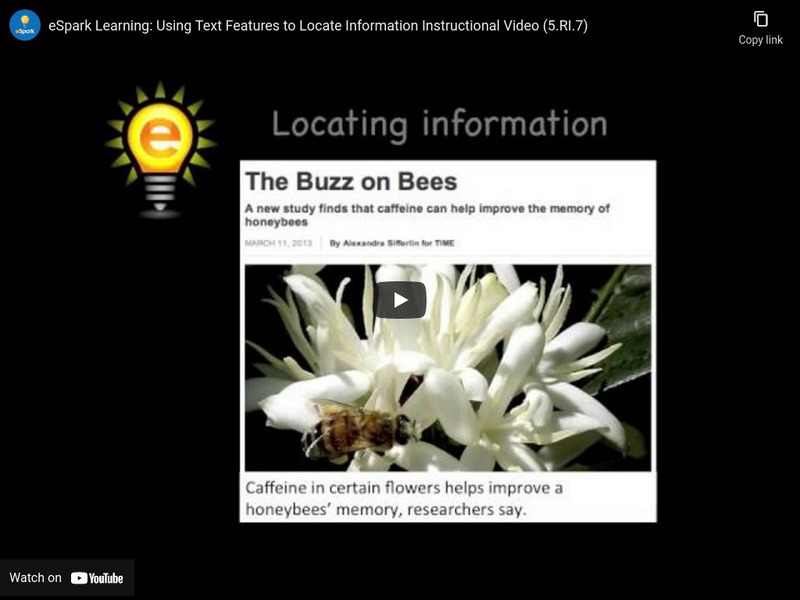Hi, what do you want to do?
Be Smart
Rise of the Superbugs
The narrator of a short video shows learners the history of antibiotics with the use of penicillin. Viewers then see how bacteria are becoming resistant to antibiotics and what that means for our future health and for the...
Be Smart
Why Are The Bees Dying?
Honeybees fly at 15 miles per hour — not bad for such a small animal! These speedy llittle creatures are the subject of a video that shows viewers how honeybees are incredibly important in the pollination world. The narrator...
Be Smart
I Don't Think You're Ready for These Jellies
If a jellyfish is cut into two parts, each part can regenerate, creating two new organisms.This phenomenon and other interesting facts about jellyfish are explored in the Monterey Bay aquarium's exhibit on jellies and talks with the...
Be Smart
A Sea Otter's Adorable Adoption Story
Sea otters, an important species in the Pacific coast kelp ecosystem, are the focus of a short video that observes sea otters in captivity. One of the few animals that use tools to help them eat, viewers see how females in captivity will...
Be Smart
Why Do We Have To Sleep?
Humans are the only mammals who delay sleep. Viewers learn this and other interesting facts in a video that explores sleep in humans. The narrator also discusses how lights affect our sleep, the importance of sleep, and how...
Be Smart
%$?# Allergies!
About 40,000 people have sinus surgery every year, hoping to relieve sinus congestion due to allergies. Learners see why some people have allergies and others don't. From flowers' pollen to pet dander, some human immune systems are...
Be Smart
The Strange Science of the Placebo Effect
Scholars see how doctors first used placebos to help soldiers during WWII with pain. Viewers then see what placebos are and how effective they can be. The narrator reminds viewers that while placebos cannot cure everything,...
Be Smart
Did Dinosaurs Really Go Extinct?
Most meat-eating dinosaurs had bones filled with air, just like today's birds. Scholars explore the idea that humans still live with dinosaurs, aka birds in a video that explains how researchers determined that modern birds...
Be Smart
What is Déjà Vu?!
Have you ever felt like you've been somewhere or seen something before? You won't get deja vu using this resource — it is totally unique! The video that explores deja vu and connections humans' brains make. Scholars see how our...
Be Smart
How Many Heartbeats Do We Get?
On average, your heart beats about 100,000 times a day. The narrator of this short video discusses how important the heart has been across cultures, from mummification to its relationship in love. He then discusses the heart rate and the...
Be Smart
How Do Squirrels Find Their Nuts?
Viewers of this short video learn how squirrels and birds not only find their stored nuts in winter but also distract would-be thieves. Viewers see that animals have the ability to take action today (burying nuts) to fulfill their...
eSpark Learning
E Spark Learning: Textual Evidence Instructional Video (7.R1.1)
This video shows an example of how to draw conclusions from an informative text and back it up with evidence from the text. [6:02]
New Zealand Ministry of Education
Te Kete Ipurangi: Thinking and Reading Comprehension
Julie Cowan from Willowbank School explains how she supports students to become strategic, reflective, and metacognitive readers and thinkers.
Sophia Learning
Sophia: Conclusions
This video lesson focuses on writing strong conclusions through strategies such as restating your thesis, summarizing your support, and calling the reader to action. It also discusses things a writer should avoid doing. [4:15]
Imagine Learning Classroom
Learn Zillion: Determine the Central Idea of a Nonfiction Article
In this lesson, you will learn how to determine the central idea of a text by determining the topic and asking what the author says about it. [6:57]
eSpark Learning
E Spark Learning: Using Text Features to Locate Information (Ri.5.7)
This video explains how to find the central idea and identify text features in print or digital nonfiction text. It uses several engaging articles as examples including one about a machine that splits Oreo cookies. [7:42]




















